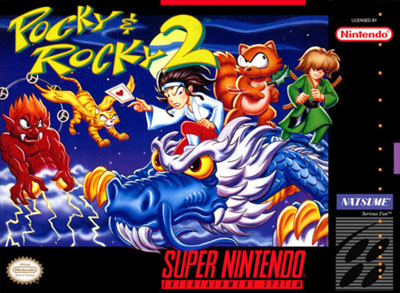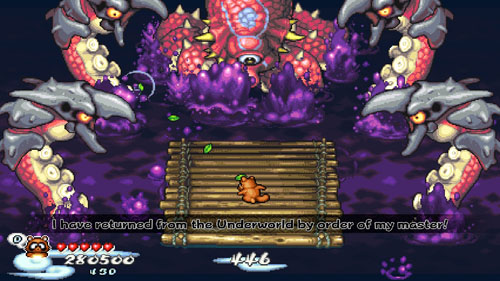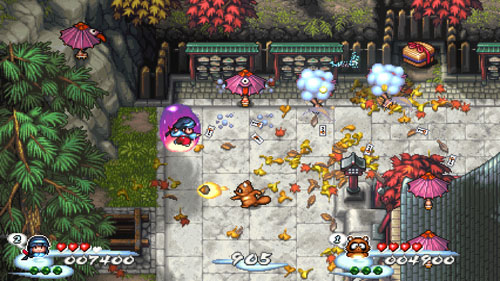A game by NatsumeAtari for Switch and PS4, originally released in 2022.
The Pocky & Rocky series got its start in Japanese arcades in 1986 with Kiki Kaikai (奇々怪界), a top-down fantasy-themed shooter starring a priestess named Sayo on a mission to rescue seven gods from the demons who kidnapped them. The priestess swings her wand, tosses projectiles in the form of paper ofuda talismans, and uses powerups to defeat enemies as she travels across multiple colorful environments, with each level ending in a boss fight against one of the demons. Players control the scrolling as they advance through the environment, and they are able to aim in eight directions, but they can only attack in the direction they're facing, operating similarly to Taito’s own Front Line (1982). A variation of this game was released on Famicom as Kiki Kaikai: Dotō Hen (奇々怪界 怒濤編) in 1987.With development changing hands to Natsume, the series made its way to the Super Famicom in 1992 with Kiki Kaikai: Nazo no Kuro Manto (奇々怪界 謎の黒マント), which was released as Pocky & Rocky on SNES in 1993. The game once again stars Sayo, now joined by a tanuki companion named Manuke, who was actually the final boss in the original game. Sayo and Manuke the tanuki are named Pocky and Rocky the Raccoon in the western release. An introductory cutscene explains that Rocky has been attacked by his former companions, and he enlists Pocky’s assistance.
Pocky once again battles her way through colorful fantasy environments – with Rocky at her side in 2P co-op – fighting enemies and taking down bosses, the first of which is actually the first boss from the original game who explains that an even greater villain is behind the recent attacks. Pocky makes use of her wand and ofuda cards, while Rocky swings his tail and tosses leaves, and both can use powerups and new abilities such as charged attacks, a slide maneuver, and the occasional rideable animal.
The series continued with a SNES sequel in 1994 called Pocky & Rocky 2, or Kiki Kaikai: Tsukiyozōshi (奇々怪界 月夜草子) in Japan. The game has additional story elements with players exploring wider environments, speaking with NPC’s, and making purchases from shops, such as items that let the characters sustain an additional hit of damage. The game also features new playable characters and support companions that have their own abilities, and there are new abilities that can be used by teaming up with each of these partners, allowing players to clear obstacles, uncover treasures, and perform team-up attacks.
In 2001, the series explored its roots on the Game Boy Advance with Pocky & Rocky with Becky, known as Kiki Kaikai Advance (奇々怪界 あどばんす) in Japan. As the name suggests, the game introduces a new playable character in the form of Becky (Miki in the Japanese version). This game, developed by Altron, eschews the new mechanics introduced in the SNES games in favor of a more straightforward arcade experience. Pocky, Rocky, and Becky each have unique powerups that affect how they use projectiles, giving each a different feel, but there is no 2P cooperative play here, which was one of the things that really made the SNES games stand out.
More than two decades have passed, but now we finally get to see Pocky and Rocky return to action in Pocky & Rocky Reshrined, known in Japan as Kiki Kaikai: Nazo no Kuro Manto (奇々怪界 謎の黒マント), from the same team who revived two other 16-bit cult classics with Wild Guns Reloaded and The Ninja Saviors: Return of the Warriors. As with The Ninja Warriors, this game offers a significant visual upgrade to the original Pocky & Rocky experience, along with some new modes and playable characters. However, despite kicking off in some familiar environments, this is not a straightforward remaster but rather a brand new adventure that acts as a kind of branching timeline.
Players who are experienced with Pocky & Rocky will notice that the introductory cutscene is very similar to that of the SNES original, and the first area is basically a straightforward recreation of the original, albeit with quite a few visual enhancements, added flourishes, and some changes to enemy placements. Even the first boss is the same… at least until he is defeated and reveals a more powerful second phase that wasn’t in the original game. But what follows is a cutscene that seems to be telling the same story.
Players are introduced to a new introductory section in the second area before diving into familiar ground, again with a few changes here and there. The second boss is a more visually impressive variant of its SNES counterpart, and offers a more technical combat experience, but that’s when things really start to change…
The Black Mantle, the main villain from the original SNES game, appears at the end of the second level and attacks Pocky, causing her soul to become separated from her body. This begins an alternate timeline where Pocky meets several new companions – each of whom eventually becomes a new playable character – and she tries to repair the damage that Black Mantle has done by resurrecting himself and travelling through time. What follows is a series of brand new levels that are unique to this game, along with a new storyline (featuring some old friends), new attack types, and new playable characters with their own combat abilities.
What further sets Reshrined apart from its predecessors is the fact that the game is initially presented as a single player experience, and that the player regularly switches between characters from one level to the next. The game begins with the player controlling Pocky in the first area, whereas the second area is played using Rocky. From there, following the separation of Pocky’s soul, she gains new combat abilities and is able to possess her new companions to make use of their skills, with playable characters continuing to alternate across the game’s eight stages.
At the start of the game, Pocky has her traditional skills, which allow her to toss ofuda cards to strike enemies at a distance, and use her wand for melee attacks. She is limited to facing in eight directions and must face the direction she wishes to attack. Rocky has corresponding skills where he swings his tail and tosses leaves. Each character also has the ability to slide along the ground to dodge enemy attacks, use a bomb to cause lots of damage to nearby enemies, and grab powerups to increase the strength of their projectiles.
Powerups come in the form of red, blue, and green orbs (called Power Balls). These impact characters’ projectiles in slightly different ways, but each color generally corresponds to a certain type of attack. Red powerups increase the strength of projectiles fired in a straight line, whereas blue powerps tend to send more projectiles outward in a wider range, and green powerups (the rarest type) offer secondary damage effects. Grabbing three of any colored orb causes these attacks to increase in strength and coverage area, while grabbing a fourth grants a temporary “max power” attack that increases your fire rate for a few seconds. Picking up an orb of another color resets you down to the first power level, per shmup tradition.
Knowing when to dish out projectiles and when to use melee attacks is key to survival, as even the opening levels feature numerous enemies attacking at once, making it easy to become overwhelmed. Despite the game’s focus on projectiles, the melee strike is actually incredibly useful... Characters can swing their wands (or tails or whatever) repeatedly to take down waves of weak enemies, knock back rows of fast moving projectiles, and take down enemies that are immune to other attacks. Hammering the MELEE button allows players to defend themselves and deal damage as knocked-back enemies and deflected projectiles cause damage to anything they hit.
After the second level, the Attack Augmentation and Purification Charge are unlocked, each of which offer limited time powerups. These abilities impact each character differently and can substantially alter the player’s strategies when facing enemies and bosses. The Attack Augmentation is activated by repeatedly pressing the FIRE button – which is otherwise not needed since all projectiles offer continuous fire – and the Purification Charge is activated by holding down the MELEE button for a few seconds.
In the case of Pocky and Uzume, their Attack Augmentation allows them to toss out mirrors (one at a time for Pocky and three at once for Uzume), and firing projectiles into these mirrors causes each of them to fire shots at the nearest enemy. This can be used to target nearby enemies, or even to take cover and attack from around a corner. Their Purification Charge, on the other hand, summons a ring of beads that spin around, automatically deflecting incoming projectiles and causing continuous damage to any enemy they touch.
These new abilities and characters mean that gameplay changes significantly based on which character the player is controlling. For instance, Uzume’s attacks originate from a pair of spinning megatama that hover near her, giving all of her attacks a wider swath, but potentially leaving her open to attacks directly in front of her. Uzume also hovers, which means that she is immune to hazards like water or bottomless pits.
Ikazuchi, the thunder weasel, has electrical attacks that hone in on enemies, but collecting red orbs grants her a wobbly energy beam that locks onto the first enemy it hits, allowing her to move freely while continuing to cause damage to her selected target (like a tamer version of the toothpaste beam in the Raiden series). Even Rocky gets a handy new ability with a Purification Charge that summons tiny raccoons to carry him around on a platform, allowing him to lock his fire in one direction while he moves in another, overcoming the game’s core conceit of requiring players to always face in the direction they’re attacking.
There are a few items that offer additional support, including a magical barrier that allows you to absorb a couple of hits of damage before it disappears, bomb pickups (bombs are not restored upon death or completing levels), the occasional 1UP, a ridable komainu that grants temporary invincibility, and healing items in the form of dango and cups of tea. Collecting health items while at full health grants a score bonus, while grabbing a magical barrier while one is active grants an even bigger bonus. There are also some characters that can be paid in coins (more on these in a bit) to spin a roulette wheel that grants one of the aforementioned items, or grants a full-strength 3-orb projectile.
The player begins the game with four hearts in his health meter, which can be lost in half-heart increments, and the player gains another heart every couple of levels for a maximum of eight. Losing a full heart also reduces the player’s attack power by one level and usually causes him to drop an orb, meaning that he can pick it up again to restore his power. Losing all hearts causes the player to lose one of his three lives, and losing all three lives boots the player to the level select screen. However, there are invisible checkpoints within the levels, so the player doesn’t have to replay the entire level from scratch.
Throughout the adventure, players face off against numerous creatures from Japanese folklore, including ghosts, demons, and enspirited objects. These enemies are rendered in a charming and colorful style that makes most of them seem to be playful rather than frightful, but there are a few creepy enemies worked into the mix, along with numerous intimidating bosses and minibosses. Boss encounters definitely require players to be mindful of their various attack and defense abilities, particularly each character’s unique Attack Augmentation and Purification Charge. Skilled players will find these encounters challenging but not overwhelming, and these encounters are made somewhat easier by the fact that getting killed returns players to a recent checkpoint with all of their health, lives, and bombs restored.
Most defeated enemies and bosses drop gold coins when killed (more coins from bigger enemies), which don’t have much of an impact on gameplay outside of the roulette-spinning NPC's. However, these have a secondary function which allows you to unlock certain options in the main menu. First off, in addition to the Normal and Hard difficulty settings, there is also an Extra Easy mode that is locked by default. By collecting 3,000 coins (cumulative across replays and deaths), this mode unlocks, thus requiring players to at least have a go at Normal mode before they take the easier route.
More importantly, the default game type is Story mode, which requires that the entire game be played as a single player experience before Free mode is unlocked. The 2P cooperative mode is locked until the player either completes Story mode or collects 10,000 coins (which can take quite a while). This may be disappointing to longtime fans of the series, but the bonus here is that the player can select between any of the characters that he has used during the Story mode, giving him up to five characters to choose from, and creating lots of new gameplay possibilities when going it alone or with a friend in local co-op.
2D CRED
Pocky & Rocky Reshrined was developed under license from Taito by NatsumeAtari, the original developer behind the Pocky & Rocky series. Development was handled by their internal team known as Tengo Project, with members who worked on the original SNES releases of Pocky & Rocky and its sequel. NatsumeAtari and Tengo Project are also known for bringing back several other classics from the 16-bit generation, including Wild Guns Reloaded and The Ninja Saviors: Return of the Warriors.
Digital versions of the game were published by Natsume, the studio most known for the long running Harvest Moon series.
Physical versions of the game were published by ININ Games, a publishing label of United Games GmbH that focuses on retro, indie, and arcade games, including Ultracore, CrossCode, Turrican Flashback, Turrican Anthology Vol. I & II, The Ninja Saviors: Return of the Warriors, and Jitsu Squad.





































0 comments:
Post a Comment